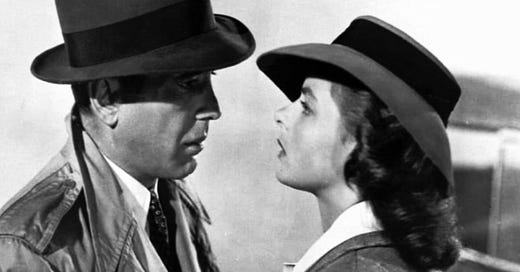“Gentlemen, we can rebuild him. We have the technology.”
-- Opening sequence, “The Six Million Dollar Man”
Some of you may recognize a popular 1970s TV series from one of those classic rerun channels. The premise was that this NASA pilot has a horrible crash, and he is rebuilt with superhuman speed and strength. Hollywood calls this sort of story “high concept,” meaning you can explain the idea in just a few words. It doesn’t need to be believable, it just needs to be fun.
What you may not know is that I think this series evolved from an idea my wife submitted, about a young woman who finds a country bumpkin and rebuilds him.
It is an old story. In Greek mythology, Pygmalion, a sculptor, was smitten with one of his sculptures, which then came to life. That story became George Barnard Shaw’s 1913 stage play, “Pygmalion,” which then became the 1956 Broadway hit, “My Fair Lady,” and then the beloved Oscar-winning 1964 movie by the same name. Who doesn’t love a good old-fashioned romantic salvage story?
In Barbara’s version, this new girl in town meets a rube, in someplace like say, Indianapolis, and decides he’s a diamond in the rough and she’s going to cut and polish the gem underneath, and they live happily ever after.
It’s April 1971, and I’m treating Barbara to a beer-steamed hotdog at the Lum’s Restaurant, over there at 55th and Keystone Avenue. We’ve only just known each other for three weeks, but it’s starting to feel as if something incredible may be happening. This all happened alarmingly quickly for us, as you will learn in detail in my upcoming falling-in-love story, “Beer Party Bride Held in Torso Slaying…” Stay tuned for that one, you won’t want to miss it.
“What kind of food is Indianapolis known for?” she asks me.
“Well, pork tenderloin sandwiches are very popular here. You take a tenderloin, cover it with breading, run over it with a Monster Truck so it spreads out to the size of an ironing board, and then you fry it up and eat it on a bun.”
“Ewwww! What else have you got?”
“Uh, you’ve lived in New York, so of course you know about beef Manhattans?”
“I don’t think so.”
“And here I thought you were so sophisticated! You take a piece of bread, put a slice of beef on it, add a scoop of mashed potatoes, then drown it in gravy. Sound familiar?”
“Yes. We just call that an open-face sandwich.”
“Not a beef Manhattan?”
“Nope. Not in New York. ”
Barbara was right. It turns out the “beef Manhattan” was created by a deli in Indy in the late 1940s and named by some World War II munitions plant workers who had been trained in Manhattan. Hence, the name.
Her questioning continued. “Let me ask you this. What’s the best restaurant in town?”
“Ah, I guess maybe that would be Stouffer’s.”
Barbara began choking on her hotdog. “Stouffer’s? Like the people who make frozen foods to eat at home? They have the best restaurant?”
“Yes. I went there once, on a date. I had the scallops, and they were tasty. But I’ve heard that now the best place is La Tour, the new restaurant at the top of the Indiana National Bank skyscraper.”
“Wait. There’s a skyscraper in Indianapolis?”
“Yes, the restaurant is on like the 35th floor. Probably has a great view.”
What neither of us could have known was that around that time, La Tour, the skyscraper restaurant, had an up-and-coming young line chef by the name of Wolfgang Puck, cooking his heart out for Hoosier tastebuds.
Of course, cuisine is not the only way to gauge someone’s sophistication. There are also movies and books and theater and art. In 1972, a few months after our wedding, we went to see a widely heralded new film, Woody Allen’s “Play it Again, Sam.” The movie opened with a puzzling black-and-white scene. There was a smokin’ hot lady, a cop, a couple of Nazis, a tough-talking dude in a trench coat and lots of fog.
I was very, very confused. Leaning over, I whispered to Barbara, “I didn’t know this was going to be in black and white.”
Her eyes turned to saucers and her jaw dropped. “No, Sweetie, see, that’s really the closing scene of another movie that… never mind, I’ll explain it later.”
It was okay with me that I had never heard of “Casablanca.” After all, she had never seen “Goldfinger,” so I figured we were sort of even. But whatever you want to say about food and films as a barometer, nothing takes the measure of a young man better than his own words. His pronunciation, his vocabulary, his colloquialisms…
One day, when I was with Barbara at a popular shopping mall, I stopped at a food kiosk. “You want some CARMEL corn?” I asked her.
“Some what?”
“You know, CARMEL corn. They toss popcorn in some melted CARMEL. It’s great!”
“It’s CARA-mel! There is an extra ‘A’ in there that you’re ignoring!”
“Oh. We’ve always just said CARMEL.”
“That doesn’t make it right.”
In one of those funny stories where time passes but nothing changes, fifty years after our first caramel exchange, we’re retired, living back in Indianapolis, and we happen to be having dinner in a really fine restaurant. It’s time to consider dessert.
“My favorite,” our helpful young waiter advises, “is the chocolate brownie. It comes with espresso ice cream, and it’s covered with CARMEL corn and CARMEL sauce.”
Barbara and I exchange knowing glances over the table, smile and decide to order that one. Ah, caramel, the sweet nectar of young love.
But back to the salvage project. Barbara worked hard to get me ready to venture out across Indiana state lines. She did it old-school, one word at a time.
“I think the Presi-DENT is on TV tonight,” I said.
“No. it’s PRES-ident. Not presi-DENT.”
“Look, there’s a bird nest up on that RUUF.”
“ROO…ROO…ROOf. Not RUUF. Repeat after me. “The PRES-ident eats his CARA-mels on the ROOF!”
“The PRES-ident eats his CARA-mels on the ROOF,” I repeated. I was bursting with pride. I now knew that if I ever witnessed the President sneaking up to the White House roof clutching a bag of Kraft caramels, I could eloquently convey that news to a waiting nation.
Barbara beamed. As they would say in ‘My Fair Lady,’ “By George, I think he’s got it!”
But here is the curious question about diamonds in the rough. How do you spot them? How do you get to be a diamond expert? I have asked my wife why, half a century ago, she decided to take on such a daunting project.
“Oh, I just knew,” she answers. “I just knew.”
So there, that totally explains it, right? No, I guess it really doesn’t, but that’s all I know, honest to God.
Coming your way on Thursday: “Hot Chocolate in the 19th Century…”






Thanks for the history lesson about Manhatens. I always wondered why only Hoosiers called them that. It is well known that people from Indianapolis have absolutely no accent at all!
Great story! As we moved from Illinois to New York in 1978, I got many lessons on “correct” pronunciation of many words foreign to my midwestern head and tongue! I can relate!